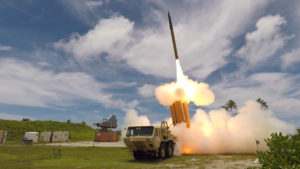HUNTSVILLE, Ala. – Lockheed Martin [LMT] is looking at how it can integrate the Terminal High Altitude Area Defense (THAAD) system into more sensors to potentially aid in defending against hypersonic glide weapons and is also taking lessons from its U.S. hypersonic missile defense bid, according to a company official.
In May, former Director of the Missile Defense Agency (MDA) Vice Adm. Jon Hill told a Senate panel he thinks “there’s likely some capability that can be leveraged” with THAAD defending against hypersonic threats, even though there has been no testing yet.

While all the missile defense threats today are technically hypersonic in speed, when it comes to hypersonic maneuvering vehicles, Lockheed Martin Vice President of Upper Tier Integrated Air and Missile Defense Dan Nimblett told Defense Daily in an Aug. 9 interview here at the annual Space and Missile Defense Symposium the current THAAD architecture has some limitations.
However, he noted the company “is investing internal research and development funds to assess, analyze and evaluate some opportunities that we see to integrate in with different sensor architectures. In a 360-degree architecture, we believe that THAAD plays a critical role in the future defense architecture,” Nimblett said.
He said the company has invested tens of millions of dollars to this effort over the “over the last couple of years.”
That assessment and analysis specifically evaluated integrating with the defense of Guam architecture and the Northrop Grumman [NOC] Integrated Air and Missile Defense Battle Command System (IBCS), set to be a key part of the Guam air and missile defense architecture, Nimblett continued.
Last year, MDA said the architecture it plans to deploy to defend the island will include IBCS, a mobile version of the Aegis Combat System, RTX [RTX] Standard Missile (SM)-3 and SM-6 missiles, the RTX Lower Tier Air and Missile Defense Sensor (LTAMDS) and Sentinel radars (Defense Daily, March 29, 2022).
That is all in addition to a THAAD battery previously deployed to Guam.
In March, Hill said he expected the first increment on Guam defense interceptors, launchers, radars and the command and control system to arrive on the island by 2024. That will include the current THAAD along with four new AN/TPY-6 radars to provide 360-degree sensor coverage (Defense Daily, March 20).
Last week, Col. Chris Hill, project manager, Integrated Fires Mission Command within U.S. Army PEO Missiles and Space, told reporters the Army and Northrop Grumman are progressing to test and integrate IBCS with LTAMDS and Indirect Fire Protection Capability (IFPC) Increment 2 launchers in preparation for the goal of the full IBCS-based activation to defend Guam by FY ‘27 (Defense Daily, Aug 14).

Therefore, the Army expects to integrate LTAMDS, IFPC, Army Long Range Persistent Surveillance (ALPS), Sentinel A3 radar, Sentinel A4 radar and Remote Interceptor Guidance-350 (RIG-360) into IBCS for use on Guam by FY ’27.
Nimblett underscored the company is developing an integration controller in an effort to allow THAAD to act either alone or integrated within a larger architecture, like at Guam.
“We’ve developed an integration controller to facilitate that sensor agnostic approach. And are certainly capable and willing to adjust that approach based on the outcome of the architecture for defense of Guam and the INDOPACOM Theater,” he said.
Nimblett also told Defense Daily that while the company is no longer participating in the Glide Phase Interceptor (GPI) hypersonic weapon competition after an MDA downselection, they are still trying to use technologies they worked on for other systems like THAAD.
“There are key technologies that were advanced in that pursuit that we are absolutely looking at and evaluating for their application in other programs. And that includes potential applications into THAAD and future capabilities that we would want to incorporate into the upper tier,” he said.
The company is particularly focused on utilizing the hypersonic defense research technology in future kill vehicles and potentially a next generation terminal defense interceptor.
“Everything from [the] kill vehicle is really where the focus has been. Are there key technology advancements that we can utilize as a part of an evolutionary development/spiral development activity, all the way up into the next interceptor for the terminal defense requirement.”
In 2021 MDA awarded contracts to RTX, Northrop Grumman and Lockheed Martin to develop and refine their concepts for GPI (Defense Daily, Nov. 22, 2021).
However, last year MDA downselected to the other two competitors, which have continued to receive modification awards continuing to refine GPI concepts (Defense Daily, June 24, 2022).